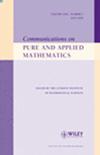Optimal regularity for supercritical parabolic obstacle problems
IF 2.7
1区 数学
Q1 MATHEMATICS
引用次数: 0
Abstract
We study the obstacle problem for parabolic operators of the type , where L is an elliptic integro-differential operator of order 2s, such as , in the supercritical regime . The best result in this context was due to Caffarelli and Figalli, who established the regularity of solutions for the case , the same regularity as in the elliptic setting.
Here we prove for the first time that solutions are actually more regular than in the elliptic case. More precisely, we show that they are C1, 1 in space and time, and that this is optimal. We also deduce the regularity of the free boundary. Moreover, at all free boundary points , we establish the following expansion:
超临界抛物线障碍问题的最优正则性
我们研究了 ∂ t + L $\partial _t + L$ 类型抛物线算子的障碍问题,其中 L 是阶数为 2s 的椭圆整微分算子,如 ( - Δ ) s $(-\Delta )^s$ ,在超临界系统 s∈ ( 0 , 1 2 ) $s \in (0,\frac{1}{2})$ 中。在这种情况下,最好的结果是 Caffarelli 和 Figalli 取得的,他们确定了 L = ( - Δ ) s $L = (-\Delta )^s$情况下的解的 C x 1 , s $C^{1,s}_x$ 正则性,这与椭圆情况下的正则性相同。更准确地说,我们证明了它们在空间和时间上都是 C1, 1,而且这是最优的。我们还推导出自由边界的 C 1 , α $C^{1,\alpha }$ 规则性。此外,在所有自由边界点 ( x 0 , t 0 ) $(x_0,t_0)$ 上,我们建立了以下扩展:
本文章由计算机程序翻译,如有差异,请以英文原文为准。
求助全文
约1分钟内获得全文
求助全文
来源期刊
CiteScore
6.70
自引率
3.30%
发文量
59
审稿时长
>12 weeks
期刊介绍:
Communications on Pure and Applied Mathematics (ISSN 0010-3640) is published monthly, one volume per year, by John Wiley & Sons, Inc. © 2019.
The journal primarily publishes papers originating at or solicited by the Courant Institute of Mathematical Sciences. It features recent developments in applied mathematics, mathematical physics, and mathematical analysis. The topics include partial differential equations, computer science, and applied mathematics. CPAM is devoted to mathematical contributions to the sciences; both theoretical and applied papers, of original or expository type, are included.

 求助内容:
求助内容: 应助结果提醒方式:
应助结果提醒方式:


